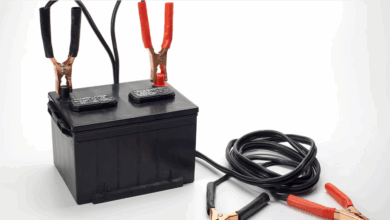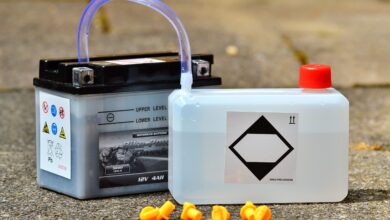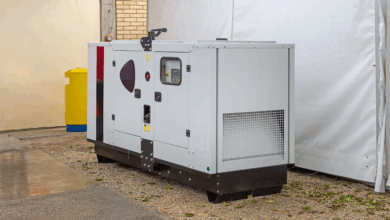Can a Generator Run on Natural Gas?

While natural gas isn’t the default fuel type for most single or dual-fuel generators, you can still safely run your generator on it with a few adjustments. If you’d rather avoid modifying your current unit, your best alternative is to purchase a tri-fuel generator designed to handle natural gas from the start.
How to Run a Generator on Natural Gas [Step-by-Step Guide]
Here’s a detailed guide based on my own testing, showing how to run your single-fuel, dual-fuel, or propane generator using natural gas.
1. How Do I Convert My Generator to Natural Gas Using a Conversion Kit?
Step 1: Purchase a natural gas conversion kit, flexible hose, and any compatible fittings. Depending on the generator size and kit complexity, this could cost between $150–$250.
Conversion kit with hose and fittings
Step 2: Safely drain or use up all remaining gasoline in the generator. Follow this [guide to draining generator fuel safely].
Step 3: Put together the conversion kit components. Carefully attach all fittings to avoid leaks.
Step 4: Detach the breather tubes from the air filter. Unclip and remove the air box to expose the inside.
Step 5: Unscrew the internal bolts securing the air box. Install the spacer or snorkel included in the gas kit. Ensure it forms a tight seal between the carburetor and the air box—any air gaps can allow debris to enter and disrupt the engine.
Step 6: Attach the conversion kit to the generator frame. You can drill mounting holes and secure it with screws.
Pro Tip: I often use light bar mounts to secure the kit without drilling. These mounts clamp securely onto the generator frame and hold the kit in place perfectly.
Conversion kit secured with light bar mounts
Step 7: Connect the gas line from the conversion kit to the snorkel or spacer. Move the generator to a well-ventilated location and attach it to a natural gas supply or LPG tank.
Step 8: Open the gas valve using the knob on the conversion kit. Refer to the manufacturer’s guide for the correct number of turns to avoid over-supplying or starving the engine of gas.
Opening the gas connection
Step 9: Start your generator and confirm it runs smoothly on natural gas.
Note: Natural gas and LPG provide lower energy output compared to gasoline. Expect a slight drop in efficiency. Natural gas typically delivers about 10% less power than LPG.
2. How to Run a Generator on Natural Gas Without a Conversion Kit?
If you’d prefer not to purchase a full conversion kit, you can still set up your generator to run on natural gas using some basic components:
You’ll need:
- ½-inch compression ball valve
- Natural gas regulator
- Hose and hose clamps
- Optional: 3 feet of copper tubing
Step 1: Open the air box and take out the air filter. Find the hose connected to the air box from the engine. Remove it to create space for the gas supply. If your generator lacks this hose, drill a hole into the air box.
Step 2: Insert a copper tube through the air box hole so that its open end faces the carburetor’s air intake path.
Step 3: Attach the compression valve to the gas hose. Start the generator using gasoline, and slowly open the valve to begin feeding natural gas to the engine. Gradually shift the fuel supply until the generator runs on gas alone.
Is It Safe to Run a Generator on Natural Gas?
Yes, as long as the installation is done properly with tight connections and no leaks, using natural gas is safe. However, if joints are loose or the setup is poorly sealed, you may run into serious issues:
- Unstable voltage output
- Difficulty starting the generator
- Risk of fire from gas leaks
- Hazardous gas buildup in enclosed spaces
- Health risks from inhaled gas fumes
- Higher gas bills due to fuel wastage
Are Natural Gas and Propane Generators the Same?
No, they differ in terms of fuel properties and hardware. Propane has a higher energy density and often requires its own set of regulators and hoses. Most dual-fuel generators are configured for propane and gasoline, while tri-fuel models include fittings for natural gas as well.
Is It Cheaper to Run a Generator on Propane or Natural Gas?
While natural gas is more affordable, propane typically yields better thermal efficiency. In some cases, propane offers nearly twice the energy per unit as natural gas. So, although you spend less per unit of natural gas, you may need more of it to match propane’s output.
How Much Does It Cost to Run a Generator on Natural Gas Daily?
Daily fuel costs can range from $0.02 to $3, depending on the generator’s size and load.
- A small 1000–2000-watt generator will use far less gas.
- Larger units (7500–15000 watts) will consume significantly more, increasing your fuel expense.
The more power you draw, the more gas you’ll use, and the higher your cost will be.
Can You Hook Up a Portable Generator to a Natural Gas Line?
Yes, absolutely. A conversion kit makes it easy to hook your portable generator to a home natural gas line. Dual-fuel generators usually require fewer modifications, while gasoline-only models need additional fittings and more complex installation.
For a better visual guide, check out the following helpful videos:
- [Green Mountain DIY Guy – Converting a dual-fuel generator to tri-fuel]
- [JOHNNY’S WEEKENDS – Modifying a gasoline generator to tri-fuel]
Can a Dual Fuel Generator Run on Natural Gas?
Yes, with a proper conversion kit or DIY setup, a dual-fuel generator can be configured to use natural gas alongside propane and gasoline.
FAQs – Frequently Asked Questions
Can All Propane Generators Run on Natural Gas?
Not by default, but you can retrofit most propane generators to use natural gas with the right modifications. Follow the steps above for guidance.
Do I Need a Regulator for My Natural Gas Generator?
Yes, a regulator is essential to control the flow and pressure of natural gas into the engine’s combustion chamber. Without it, the engine may not function correctly or safely.
What Natural Gas Pressure Is Required for Generators?
Most models operate best with natural gas pressure ranging from 0.18 to 0.25 psi (5–7 inches water column or 9–13 mm Hg).




![How to Bypass CO Sensor on Generator – [4-Step Safety Guide]](https://www.generator411.com/wp-content/uploads/2025/08/co-sensor-on-generator-390x220.png)